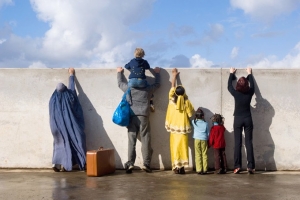Once you start thinking about economic growth, it is hard to think about anything else. — paraphrased version of statement by Nobel Prize-winning economist Robert Lucas
Ending absolute poverty has been a Holy Grail for development economists, and many others, for the past half century. However, it has been difficult to identify specific policy programs which governments can pursue to end human poverty. One policy program which some development researchers believe would contribute greatly to ending global poverty is more liberal migration laws allowing greater freedom of movement across international borders.
Those who argue that migration can play a large role in ending poverty base this on a few key pieces of evidence:
- There is a place premium: The same person, without any change in skills or in the number of hours worked, can earn a considerably higher income in some countries than in others. Thus, migration is almost a “free lunch” for these workers and the richer economies they can work in. The causes for the place premium are complex, but they are believed to be some combination of economic systems, legal systems, and culture/social structure than enable better use of a person’s talents.
- A significant fraction of people from poor countries have escaped poverty through migration. For instance, among those born in Haiti who are today not in poverty, 82% escaped poverty by leaving Haiti. For more on this research by Michael Clemens and others at the Center for Global Development, see the income per natural page and the linked research.
- When there is freedom of movement between countries, there is rapid convergence between the incomes earned by people in comparable jobs. Migration plays an important role in this, both directly and via remittances and by creating a more interconnected world.
The overall effects of open borders are expected to be a one-time boost to world GDP of about 50-150%.
Among the development economists who have been promoting more open borders as an important component of the strategy against world poverty are:
- Lant Pritchett: See this Cambridge Nights video and this Reason Magazine interview.
- Michael Clemens: See this video.
Compared to most anti-poverty programs, immigration is one of the most successful, and it pays for itself. In a blog post titled Microcredit versus Immigration, David Henderson quotes from Robert Guest’s book Borderless Economics the following passage:
When people try to think of ways to ease global poverty, they seldom mention migration. They tend to instead think of things like microcredit. There is nothing wrong with microcredit (the lending of small sums of money to poor entrepreneurs). It has lifted many people out of poverty, which is why Mohammed Yunus, whose Grameen Bank pioneered this approach in Bangladesh, won the Nobel Peace Prize in 2006. Yet, as Mr. Pritchett points out, the average gain from a lifetime of microcredit in Bangladesh is about the same as the gain from eight weeks working in the United States. After doing a quick calculation of the total benefit that Grameen Bank confers on its clients, he asks, mischievously: “If I get 3,000 Bangladeshi workers into the US, do I get the Nobel Peace Prize?”
Writings by others on migration as a tool to end or drastically reduce poverty
- How migration liberalization might eliminate most absolute poverty by Carl Shulman, May 27, 2014.
- Migration can end worldwide poverty by Mirko Bagaric, Sydney Morning Herald, April 7, 2010.
- Immigration Reform and Hunger, Bread for the World.
- Moving out of poverty – making migration work better for poor people by the Department for International Development (DFID), UK, 2007.
Addressing claims of futility
- Roy Beck unwittingly makes the case for open borders by Vipul Naik, March 20, 2012, on the Open Borders blog, addresses pessimistic futility arguments.
- Optimistic futility arguments against open borders by Vipul Naik, August 20, 2012, on the Open Borders blog, addresses optimistic futility arguments.
Personal reminiscences
- World poverty by Nathan Smith, February 17, 2013, for the Open Borders blog.
The image featured at the top of this page depicts people reaching over a wall barring them from migrating, and was created by the European Commission.


7 thoughts on “End of poverty”
Comments are closed.